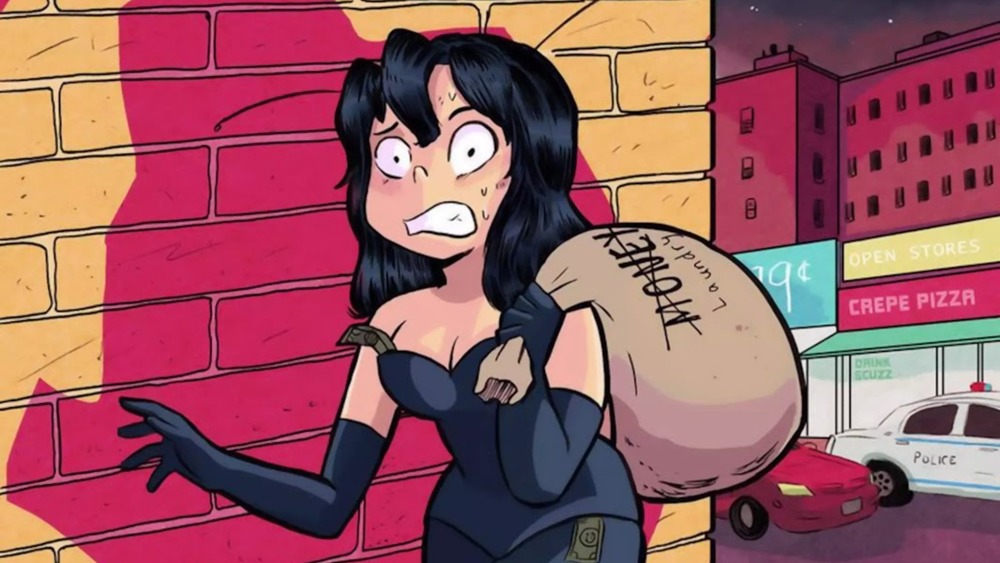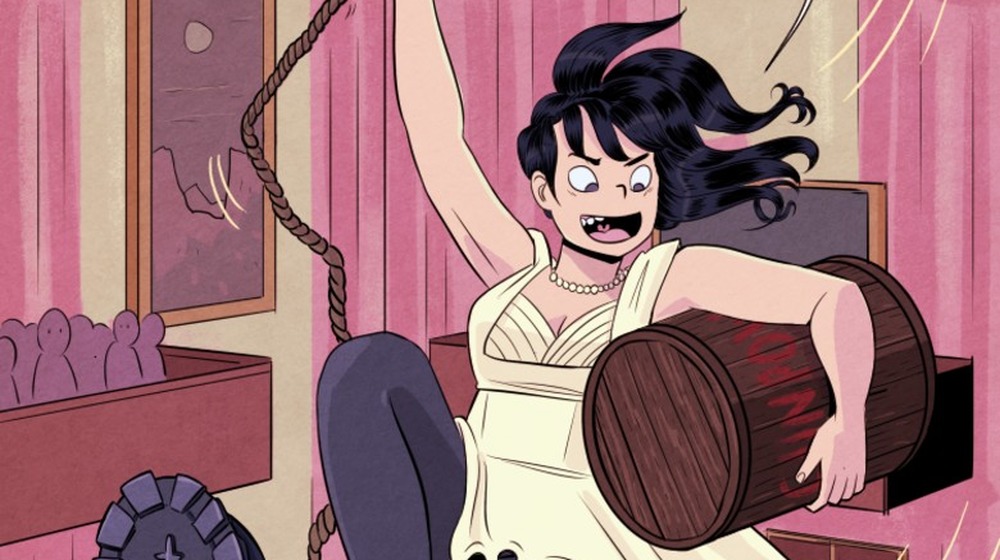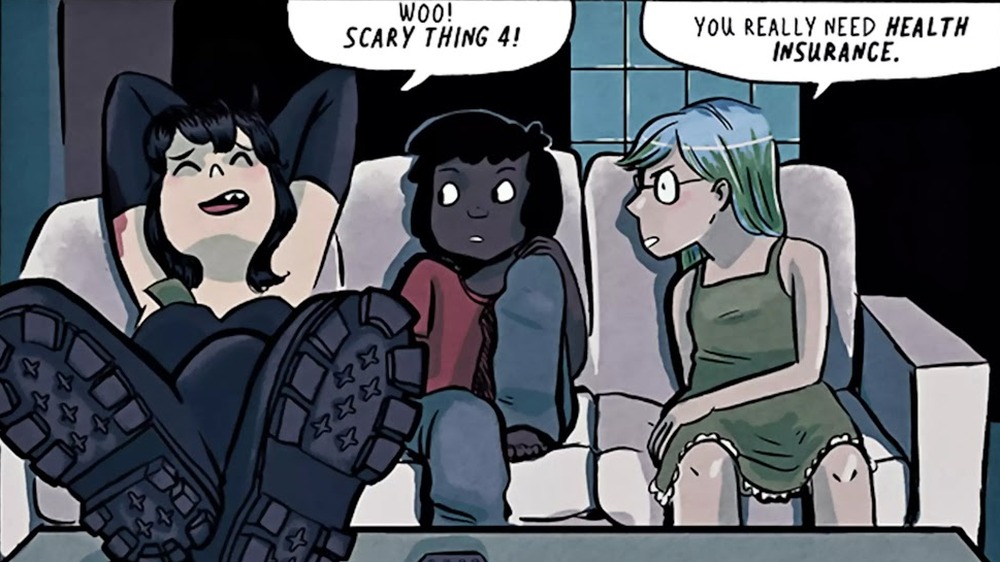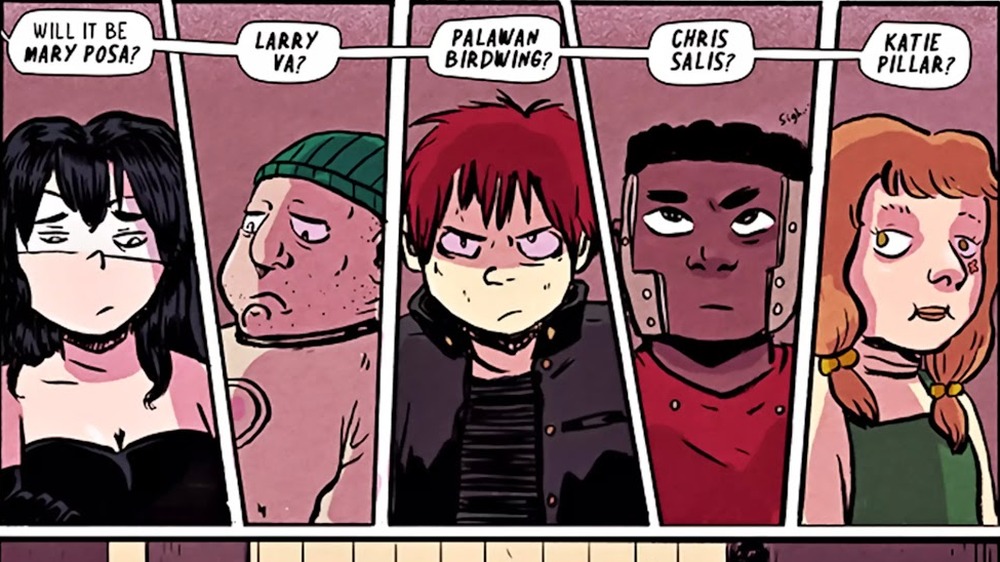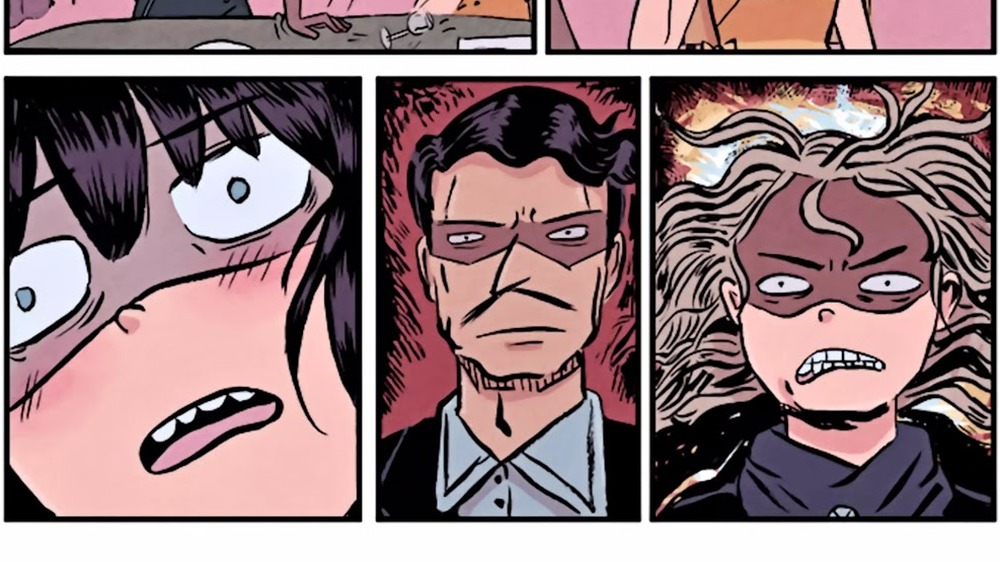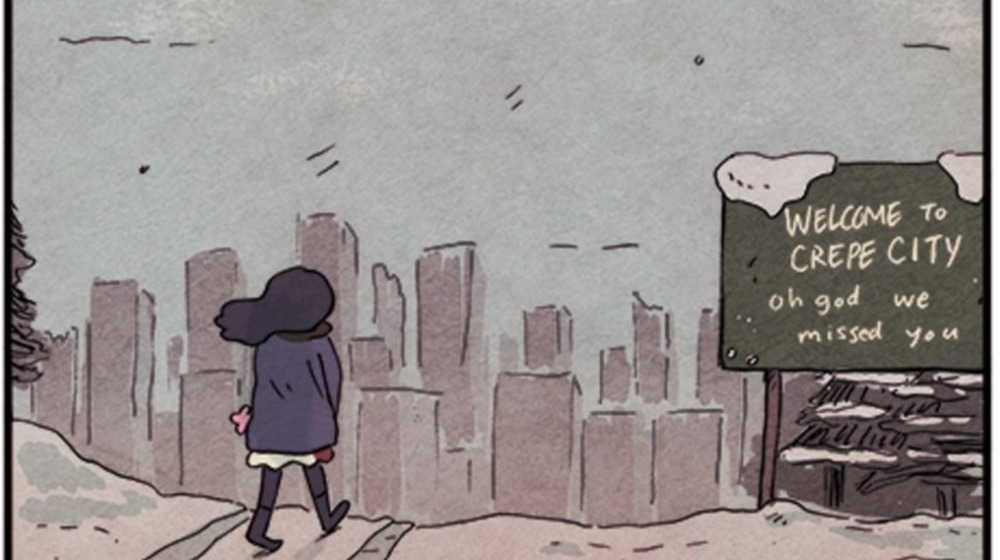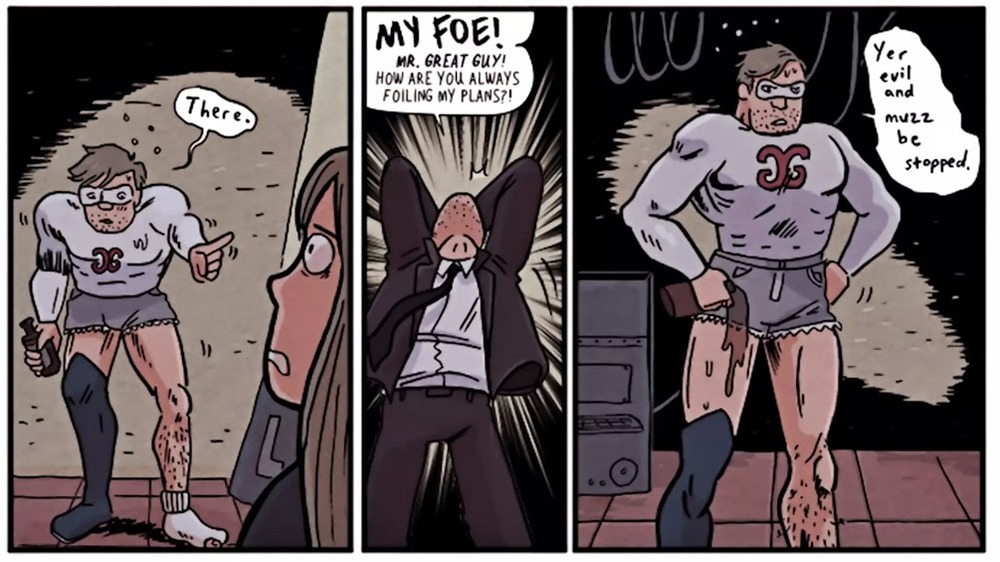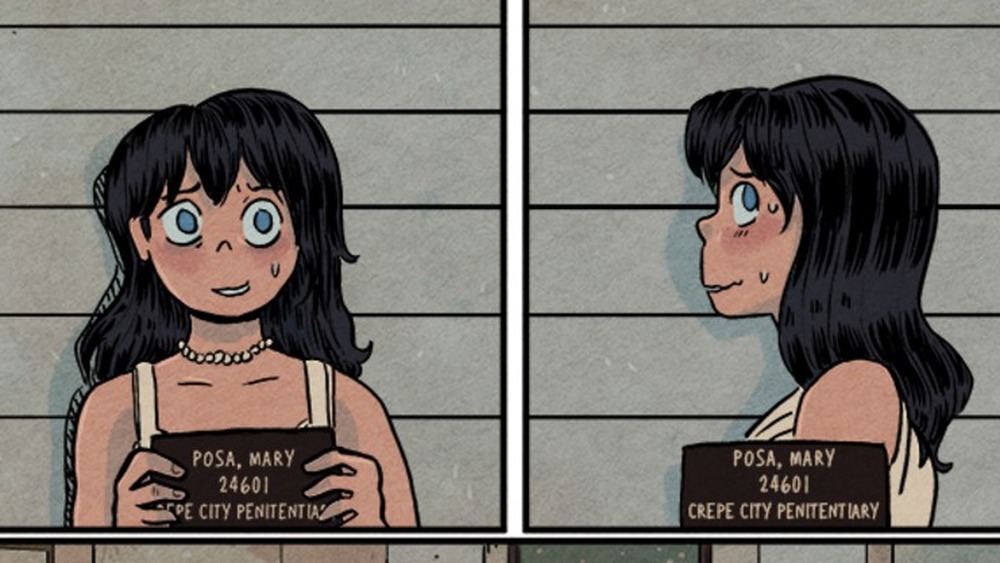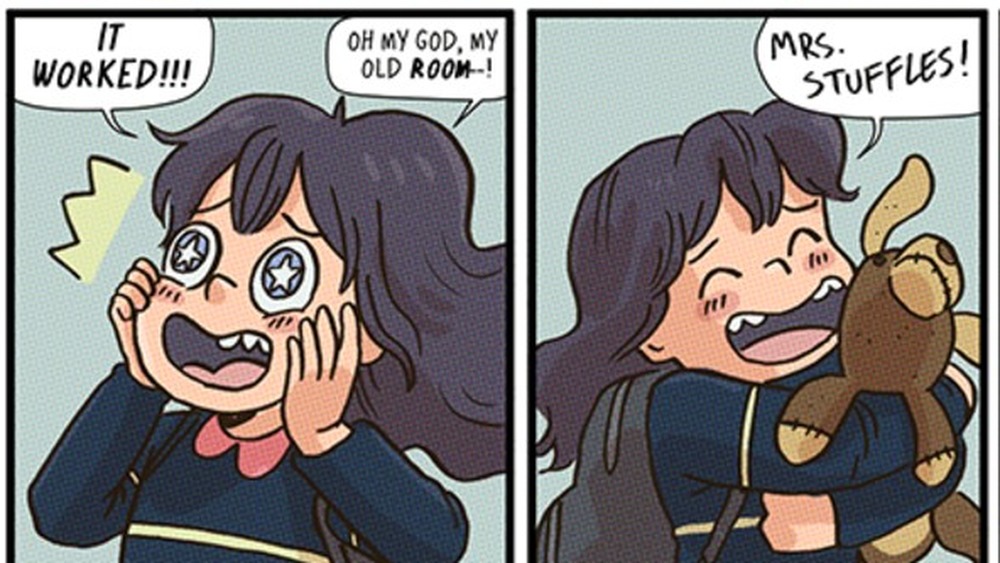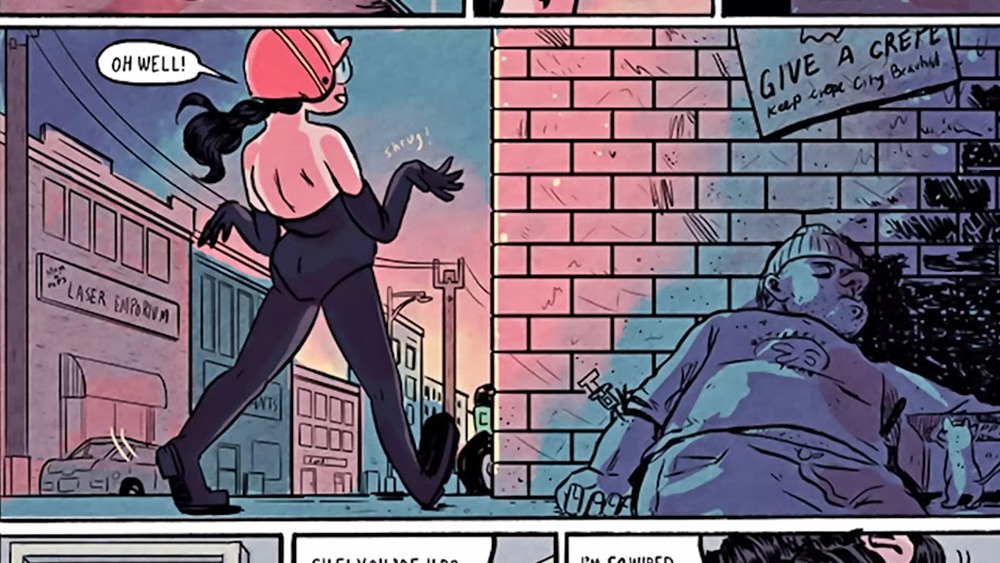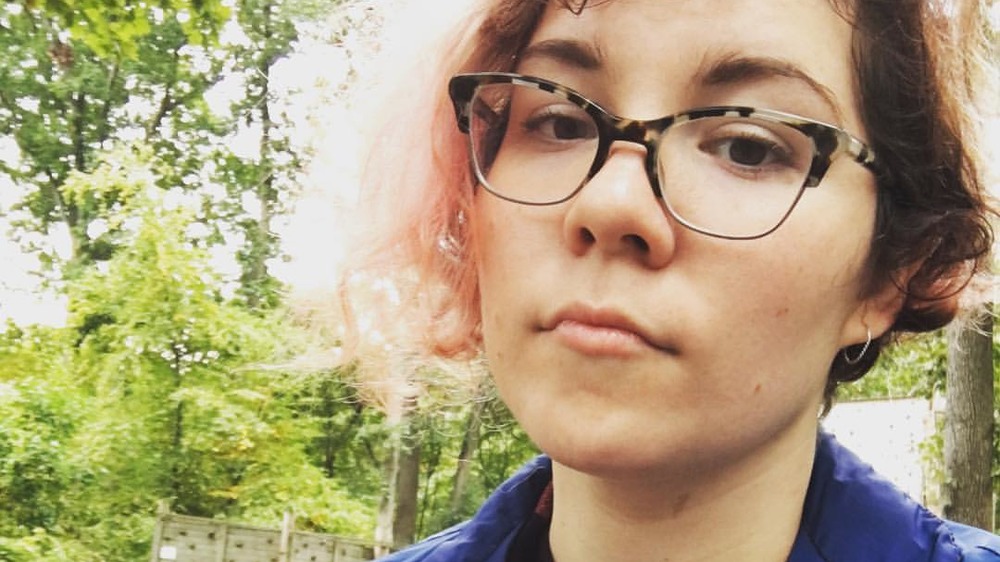The Untold Truth Of Henchgirl
In early November 2020, news broke that Freeform was adapting the comic book Henchgirl for television. While the name might not be as well known as Superman or Batman, Henchgirl has gained a strong following since it originally appeared as a webcomic, and it started being reprinted in single issues by Scout Comics in 2015.
So what is Henchgirl, and why should you care? Well, like a lot of comic books, Henchgirl deals with a fictional metropolis guarded by superheroes and plagued by supervillains. But rather than revolving around the action or the earth-shattering consequences of cataclysmic battles between good and evil, Henchgirl focuses on one young woman just trying to get by in a world even crazier than our own. The series has earned a good deal of acclaim, including from The Guardian, which called it "a snarky slacker story with appealing, Scott Pilgrim-style art."
To learn more about this fun, hilarious, and occasionally heartbreaking series, keep reading for the untold truth of Henchgirl.
(Warning — there are spoilers below.)
Who is Henchgirl?
Henchgirl isn't a superhero or a supervillain, but instead, as the title suggests, she's a henchgirl or — perhaps more appropriately — a henchwoman. Her name is Mary Posa, and she lives in Crepe City with her two roommates, Tina and Sue. Mary pays for her share of the bills by working as part of the Butterfly Gang, the loyal(ish) employees of the meekly named supervillain Monsieur Butterfly.
A number of times during Henchgirl, Mary and others comment on her not having any super powers of her own. In spite of this, she often displays freakish amounts of strength, at one point even knocking down the powerful superhero Mr. Great Guy. She also has the uncanny — and we're not convinced completely voluntary — ability to just pass out in random places. For example, early in Henchgirl #1, she passes out while walking down the street, landing unceremoniously in a pile of garbage bags.
While Mary is technically a criminal, she isn't a cruel person. She enjoys the excitement of stealing, and she likes the payday, but she does her best to avoid actually hurting people or taking advantage of particularly vulnerable targets. For example, when Monsieur Butterfly chooses to exploit the St. Crepicius Home for Orphans, Mary bends over backwards trying to get her boss to focus on a different heist.
Henchgirl has some interesting roommates
Living in a thriving metropolis like Crepe City ain't cheap, even if it's occasionally the site of apocalyptic alien invasions. So, Mary Posa doesn't live alone. Her roommates, Sue and Tina, can never really tell when Mary will come home or when she'll wake up. Both of them know about her criminal occupation, and they have very different reactions to it.
Tina always loves to hear about Mary's criminal exploits, and she seems to harbor a secret desire to become more like Mary. Whenever Mary tells stories about what's going on with her and the Butterfly Gang, Tina reacts with gleeful enthusiasm. We eventually learn Tina has a super power. Tina can somehow spontaneously create carrots, which push themselves out of her wrist from under her skin. Some of these carrots actually grow to the size of humans, develop personalities, teach martial arts, etc. The revelation Tina has this ability in Henchgirl #3 leads to a good deal of nausea on the part of her roommates, who suddenly realize why she just made them carrot cake.
Sue, while not exactly a "mother hen," is certainly the most responsible of the three roomies. Whenever Tina gets excited about Mary's criminal anecdotes, Sue reminds Mary to relate the negative side of her job, so she isn't too much of a negative influence on Tina. If someone's nagging Mary about the hours she keeps or reminding her that relying on mad scientists for medical care is a bad idea (whether or not they charge copay), it's Sue.
Who exactly is the Mannequin?
Superhero drama and romance go hand in hand, and that's also true in the world of Henchgirl. As for Mary, her love interest is Fred, aka "the Mannequin." She meets Fred early in Henchgirl #1, when he finds her passed out in a pile of garbage and carries her home. She doesn't recognize him from behind the counter the next day, when she makes a deposit at the same bank where he works. She still doesn't recognize him when she goes undercover as a caterer at the home of millionaire Greg Gaines. But after she decides to try her hand at catering full-time, she eventually recognizes the not particularly effective vigilante and recruits him to help save the St. Crepicius Home for Orphans from the Butterfly Gang.
As the Mannequin, Fred has a power that is, well, it's kind of useful but it has a pretty big drawback. Fred can astrally project himself from his body, allowing him to do things like eavesdrop on bad guys. But while Fred's spirit is floating around, his body transforms into a hollow statue made of some kind of ceramic-like material. It breaks easily, leaving Fred's allies to glue his body back together the best they can before he returns to it.
However, that's not his only gift. Later in Henchgirl, the new Crepe City hero, Celestial Angel Amelia, takes Fred on as a sidekick. While they're getting to know each other, they learn it's Fred's touch that activates the legendary Timekeeper device, inspiring Fred to rename himself "the Time Baron."
If nothing else, the Butterfly Gang is very dedicated to its theme
For most of Henchgirl, Mary Posa is a member of the Butterfly Gang — the henchwomen and men who work for Crepe City mastermind Monsieur Butterfly. As a supervillain, Monsieur Butterfly doesn't seem to have a whole lot of things going for him. We never see him display any actual powers, but he does have a lot of butterfly-themed clothes and equipment. He demands the butterfly theme be adhered to whenever possible, including handing off payment to black market weapons dealers in pink butterfly backpacks.
All the members of the Butterfly Gang have names related to the attractive insects. Mary Posa is a play on mariposa, the Spanish word for butterfly. There's also Larry Va, Palawan Birdwing, Chris Salis, Katie Pillar, and — last but never least — Coco Oon. It isn't made clear whether or not Monsieur Butterfly chooses his hirelings for their butterfly-themed names or if all of his employees are required to endure legal name changes for the sake of theme.
Once every seven days, Monsieur Butterfly chooses a member of the gang as Employee of the Week by allowing them to wear butterfly wings. The pretty Coco Oon is almost always chosen for this honor, and you get the distinct impression the rest of the gang is less than happy about it. Mary gets along well enough with just about everyone in the gang, though not so much with Coco. That changes later in the story when Mary and Coco learn they have more in common than they realized.
Henchgirl comes from superhero royalty
For the first few issues of Henchgirl, you don't know much about Mary's past, but in Henchgirl #4, an important detail is unveiled. When Fred shows interest in attending a book signing for A Super Family: A Memoir, where the married superheroes Flame Girl and El Romancero are in attendance, Mary is firmly against the idea, initially claiming she doesn't want to go because she's afraid it could give the Butterfly Gang an opportunity to get to Fred. Eventually, Fred and her roommates pressure her to go with them, and as they wait in line, Mary wears dark glasses and a scarf over her mouth and nose. As they reach the table where the superhero family waits, she reveals herself with dramatic flare to the superheroes ... who are her parents.
It isn't long before Mary's friends discover why she didn't want to reunite with her family. Her parents treat them all to dinner, but during the meal, they learn that Mary isn't mentioned at all in their popular new book. Instead, they focus on Mary's sister, Photo-Girl. Enraged, Tina blurts out that Mary is in the Butterfly Gang. Mary's mother, Flame Girl, is so angry at the news that she sets the restaurant on fire. But in spite of her parents' failure to value Mary, Photo-Girl doesn't feel the same toward her sister. She returns later in the series, hoping to help her in ways only she can.
Henchgirl's city is Crepe-tastic
We don't know if Henchgirl creator Kristen Gudsnuk loves crepes, hates crepes, picked the name at random, or has a personal anecdote involving crepes. Regardless, Henchgirl is not only set in Crepe City, it's chock-full of crepe references – even though, come to think of it, there may not be a single actual crepe in the entire story.
Pay attention to the details while reading Henchgirl, and you notice lots of things in Crepe City are named after those thin, French pancakes. The cover of 2015's Henchgirl #1 reveals a store called Crepe Pizza, which could be delicious or disgusting, depending on how you define crepe pizza. Mary's gang plots a crime involving St. Crepicius Home for Orphans, a sign posted on a wall encourages citizens to "give a crepe" about keeping the city beautiful, and Mary has a job interview at the popular restaurant Crepelbee's. A close look at Mary's phone reveals the network name Crepizon, the city's biggest news station is CNN (Crepe News Network), and one of the best ways to do research is through the website Crepipedia. And you can tell your social network all about it on Crepebook.
Paying close attention to what's in the background is a good idea in Henchgirl even when crepes have nothing to do with it. Gudsnuk comes up with wonderful business names like "Florist for the Trees," the supermarket "Shop & Shop," and the martial arts dojo "You Kwon Do It!"
Mr. Great Guy, hero of Crepe City
It's a testament to how iconic Superman has become that every superhero parody or send-up needs its own stand-in for the Man of Steel. The Boys, for example, has Homelander, while Henchgirl has the much more modestly named Mr. Great Guy. Mary Posa doesn't have a lot of direct interaction with Mr. Great Guy, but when she does, it's memorable. For example, take the opening pages of Henchgirl #1, when the hero sets Monsieur Butterfly's Butterfly Buggie on fire while Mary is in the driver seat, texting her roommate, Sue.
Sadly, by the end of Henchgirl, Mr. Great Guy has fallen on hard times. When giant worm-like aliens — the Glorbons from Kromule 5 — attack Crepe City in Henchgirl #3, heroes like Mr. Great Guy, Superlady, and the beer-sponsored Joe Sixpack defeat the invaders, but not without loss. The love of Mr. Great Guy's life — intrepid reporter Lana Street — is decapitated during the battle. In shock, Mr. Great Guy futilely tries to resurrect her by fusing her head back onto her body with his heat vision.
The rest of the hero's appearances don't make him appear quite so "great." He's often drunk while fighting crime, and in at least one case, his confrontation with villains ends with him calling out in vain to his late lover and then vomiting.
Henchgirl goes bad
For most of Henchgirl, Mary is a fairly decent person. Even though she commits crimes, she does her best to stop people from getting hurt, as well as trying to stop her colleagues in the Butterfly Gang from taking advantage of anyone who can't fight back. For reasons beyond our hero's control, that all changes in Henchgirl #6.
Suspecting the truth already, Monsieur Butterfly's favorite employee — Coco Oon — tricks Mary into confessing that she betrayed the team to protect helpless orphans. The gang ties Mary up and brings her to Dr. Eugene Maniac, who treats her with a so-called "Evil Serum" that, you guessed it, turns her evil. Soon afterward, Mary beats the tar out of Consuelo, a friend she first met while catering. It doesn't take long before she's taking money from street performers, waiting outside elementary schools to steal lunch money from students, and liberating dozens of puppies from pet stores. Things come to a head when she murders a supervillain at a fancy gala.
Eventually, Mary tries to fix the bad things she does, but predictably, doing so makes things worse.
Rebooting the timeline
To reboot its continuity, DC Comics had crossover events like 1985-86's Crisis on Infinite Earths and 2011's the New 52. For Mary Posa, it's 2016's Henchgirl #10. Having long harbored a jealous resentment toward Celestial Angel Amelia for stealing Fred away from her, Mary goes incognito as the only follower of Amelia's blog, allowing her to learn how to use the legendary Timekeeper device. After teaming up with Coco Oon to capture Amelia, Mary uses the Timekeeper to go back in time and "fix" her life.
Rather than allowing her parents to ignore her because of her lack of unique super powers, Mary uses her knowledge of the future to fool the world into believing she's a psychic. No longer the forgotten daughter, Mary becomes the Psychic Tot. Her superhero parents bring her on television and radio interviews, along with sending her to the Rodney Cummerbund Afterschool for Gifted Young'uns where she trains alongside Little Good Boy — future Mr. Great Guy — among others.
She also uses the opportunity to humiliate her childhood bully, let an elementary school classmate know he'd grown up to become a billionaire, and give a younger Coco Oon lucrative stock tips (though a sobbing Coco would inform her that her "vast wealth" would prove to be an "intrinsic part" of her "tragic past"). Unfortunately when Mary snaps back to present day, nothing much has changed beyond her clothes.
Henchgirl has a dark streak
Henchgirl is compared quite a bit to Bryan Lee O'Malley's Scott Pilgrim graphic novel series for its similar brand of irreverent snark. And that's an apt comparison most of the time. However, Henchgirl occasionally surprises you by revealing a much darker edge than the adventures of O'Malley's Canadian hero.
We catch a glimpse of this as early as the premiere issue. Monsieur Butterfly sends Mary and Larry Va to buy weapons from a gang called the Molotovs. While they're waiting for the weapons dealers, Larry manipulates Mary into not only covering for him but giving him some cash. Larry mentions that it's his daughter's birthday, and Mary tells him to go and slips him some money. After she successfully negotiates the purchase of a new butterfly-themed weapon for her boss and later saves Fred from a pack of goons, she heads home. But as she's walking home, we spot Larry unconscious in the shadows of an alley, with a needle in his arm. Apparently, his daughter's birthday wasn't the appointment he was desperate to get to.
The series also features some briefly shockingly violent moments. We see one of these just before Mary is arrested and another in her final battle against Celestial Angel Amelia. Believe it or not, one of the goriest scenes comes courtesy of Tina's carrot-sprouting powers.
Meet Kristen Gudsnuk, creator of Henchgirl
Originally published as a webcomic, later put to print by Scout Comics, and eventually collected as a trade paperback by Dark Horse, Henchgirl is the creation of writer and artist Kristen Gudsnuk. Gudsnuk's other work includes the middle school-set Making Friends and the urban fantasy mini-series Modern Fantasy, which is about an adventurer stuck in a lame a desk job.
Speaking to Women Write about Comics in November 2019, Gudsnuk said that Henchgirl was where she learned her trade. "You can see me figuring out how comics work on the pages," she said of Henchgirl. "You can see obvious things, like me figuring out how to do lettering or perspective, but also different storytelling techniques." Gudsnuk went on to name Rumiko Takahashi — known for her manga series Ranma ½ and Inu-Yasha — as her "number one influence." She also mentioned other manga like Sailor Moon and Dragon Ball Z, 19th-century literature, and Terry Gilliam's dystopian film Brazil as sources of inspiration.
In a 2017 interview with Outright Geekery, Gudsnuk said part of what inspired her to create Henchgirl was the notion of what's going on in the lives of superhero comics' more "peripheral" characters. "How do they make money? Pass the time? Do they have friends, coworkers?" Gudsnuk said. "How can these mythic stories coexist with mundane ones? I wanted to shift the perspective of a big superhero comic to focus on the smaller and more relatable stories happening just outside the panels."
